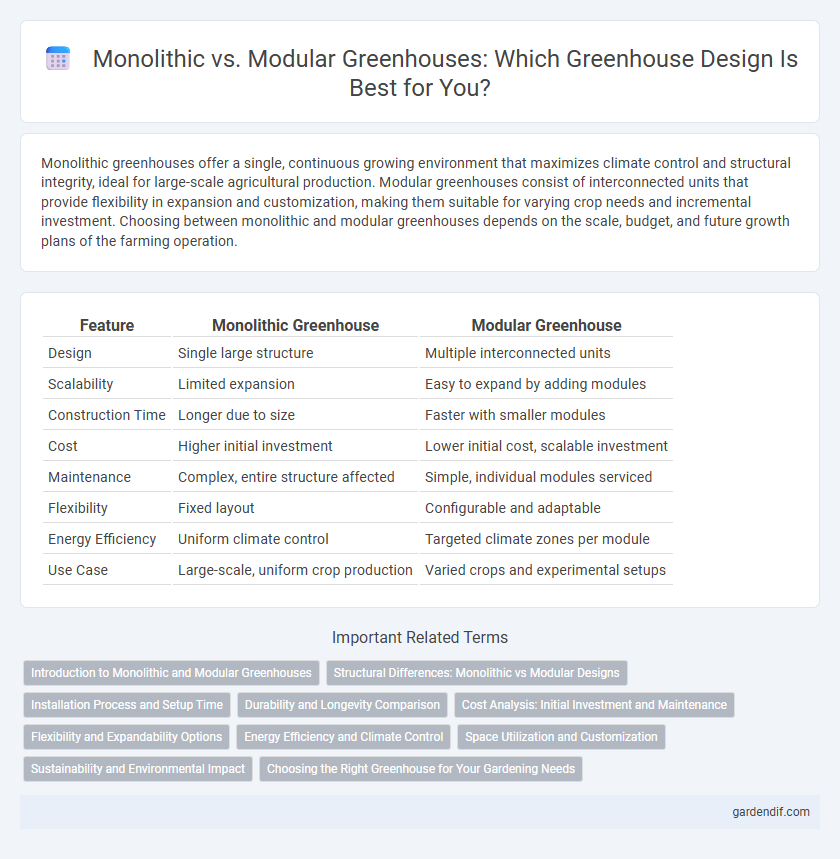
Monolithic vs modular greenhouses Illustration
Monolithic greenhouses offer a single, continuous growing environment that maximizes climate control and structural integrity, ideal for large-scale agricultural production. Modular greenhouses consist of interconnected units that provide flexibility in expansion and customization, making them suitable for varying crop needs and incremental investment. Choosing between monolithic and modular greenhouses depends on the scale, budget, and future growth plans of the farming operation.
Table of Comparison
| Feature | Monolithic Greenhouse | Modular Greenhouse |
|---|---|---|
| Design | Single large structure | Multiple interconnected units |
| Scalability | Limited expansion | Easy to expand by adding modules |
| Construction Time | Longer due to size | Faster with smaller modules |
| Cost | Higher initial investment | Lower initial cost, scalable investment |
| Maintenance | Complex, entire structure affected | Simple, individual modules serviced |
| Flexibility | Fixed layout | Configurable and adaptable |
| Energy Efficiency | Uniform climate control | Targeted climate zones per module |
| Use Case | Large-scale, uniform crop production | Varied crops and experimental setups |
Introduction to Monolithic and Modular Greenhouses
Monolithic greenhouses are constructed as a single, unified structure, offering enhanced thermal mass and durability, which optimize climate control for extended growing seasons. Modular greenhouses consist of interchangeable sections or modules, providing flexibility in design, easier expansion, and simplified maintenance tailored to varying agricultural needs. Selecting between monolithic and modular greenhouses depends on factors like budget, crop type, and scalability requirements.
Structural Differences: Monolithic vs Modular Designs
Monolithic greenhouses feature a continuous, seamless structure often made from materials like polycarbonate or glass, providing superior insulation and durability. Modular greenhouses consist of prefabricated, interchangeable panels or units that allow flexibility, ease of expansion, and simpler repairs. Structural differences impact thermal performance, construction complexity, and cost-effectiveness in both monolithic and modular greenhouse designs.
Installation Process and Setup Time
Monolithic greenhouses feature a single, continuous structure that requires extensive groundwork and precise assembly, often resulting in longer installation times. Modular greenhouses consist of prefabricated, interchangeable components that simplify the setup process and significantly reduce installation time, allowing for easier customization and scalability. The streamlined assembly of modular systems enhances efficiency, making them ideal for rapid deployment and flexible expansion.
Durability and Longevity Comparison
Monolithic greenhouses, typically constructed from a single material or structural system, offer enhanced durability due to fewer joints and points of failure, resulting in longer structural integrity under harsh weather conditions. Modular greenhouses, composed of interchangeable units, provide flexibility and easier maintenance but may experience more wear at connection points, potentially reducing overall longevity without regular upkeep. Choosing between monolithic and modular depends on balancing durable, long-lasting construction against adaptability and ease of repair for prolonged greenhouse performance.
Cost Analysis: Initial Investment and Maintenance
Monolithic greenhouses typically require a higher initial investment due to the use of uniform, often heavier materials and complex construction processes. Modular greenhouses offer cost-effective scalability with lower upfront expenses and simplified maintenance owing to interchangeable parts and standardized components. Over time, modular designs reduce maintenance costs by enabling easy replacement of damaged sections without extensive structural modifications.
Flexibility and Expandability Options
Monolithic greenhouses offer limited flexibility and expandability due to their single-structure design, making modifications more complex and costly. Modular greenhouses provide greater adaptability with interchangeable components, enabling easy expansion and customization to suit changing cultivation needs. This modular approach allows for scalable growth and swift reconfiguration without significant structural changes, optimizing operational efficiency.
Energy Efficiency and Climate Control
Monolithic greenhouses, constructed with a single solid structure, offer superior insulation and consistent internal temperatures, enhancing energy efficiency through reduced heat loss. Modular greenhouses provide flexible climate control by allowing individual sections to be managed independently, optimizing microclimates for diverse plant needs. Choosing between monolithic and modular designs depends on balancing energy conservation priorities with the complexity of climate management required for specific crops.
Space Utilization and Customization
Monolithic greenhouses maximize space utilization through a continuous, single-structure design that offers consistent environmental control and fewer structural interruptions. Modular greenhouses provide superior customization by allowing growers to expand or modify sections independently, adapting to specific crop needs or evolving production goals. Efficient space use in monolithic designs contrasts with the flexible configuration potential found in modular systems, making choice dependent on operational priorities.
Sustainability and Environmental Impact
Monolithic greenhouses, constructed as a single uniform structure, often result in higher energy consumption due to limited ventilation options and less adaptability to environmental changes. Modular greenhouses offer superior sustainability by enabling customized climate control, reducing energy usage, and allowing for easy scalability and maintenance with minimal waste. Their design promotes better resource management, lower carbon footprint, and enhanced integration of renewable energy technologies.
Choosing the Right Greenhouse for Your Gardening Needs
Choosing the right greenhouse depends on your gardening goals, space, and budget. Monolithic greenhouses offer durability, better insulation, and a unified structure ideal for year-round growing, while modular greenhouses provide flexibility with customizable sections that are easy to expand or repair. Prioritize factors like climate control, plant variety, and available space when deciding between a monolithic or modular greenhouse to optimize plant growth and maintenance efficiency.
Monolithic vs modular greenhouses Infographic

 gardendif.com
gardendif.com